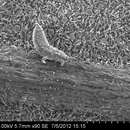en
names in breadcrumbs


Thrips (Order Thysanoptera) are tiny, slender insects with fringed wings (thus the scientific name, from the Greek thysanos (fringe) + pteron (wing) (Tipping 2008)). Other common names for thrips include thunderflies, thunderbugs, storm flies, thunderblights, and corn lice. Thrips species feed on a large variety of sources, both plant and animal, by puncturing them and sucking up the contents. A large number of thrips species are considered pests, because they feed on plants with commercial value. Some species of thrips feed on other insects or mites and are considered beneficial, while some feed on fungal spores or pollen. So far around 5,000 species have been described. Thrips are generally tiny (1 mm long or less) and are not good flyers, although they can be carried long distances by the wind. In the right conditions, many species can exponentially increase in population size and form large swarms, making them an irritation to humans.
Like the words sheep, deer or moose, the word thrips is used for both the singular and plural forms. So while there may be many thrips there can also be a single thrips. The word thrips is from the Greek, meaning wood louse (Kirk 1996).
Thrips are small hemimetabolic insects with a distinctive cigar-shaped bauplan: elongate with transversely constricted bodies. They range in size from 0.5 to 14 millimetres (0.020 to 0.55 in) in length for the larger predatory thrips, but most thrips are approximately a millimetre in length. Flight-capable thrips have two similar, strap-like, pairs of wings with a ciliated fringe, from which the order derives its name. Their legs usually end in two tarsal segments with a bladder-like structure known as an arolium at the pretarsus. This structure can be everted by means of hemolymph pressure, enabling the insect to walk on vertical surfaces (Heming 1971, Gillott 2005).
Thrips have asymmetrical mouthparts that are also unique to the group. Unlike the Hemiptera, the right mandible of thrips is reduced and vestigial - and in some species completely absent. The left mandible is larger, and forms a narrow stylet used to pierce the cell wall of tissues (Childers & Achor 1989). Some species may then inject digestive enzymes as the maxillary stylets and hypopharynx are inserted into the opening to drain cellular fluids (Hunter & Ullman 1989, Hunter et al. 1994). This process leaves a distinctive silvery or bronze scarring on the surface of the stems or leaves where the thrips feed (Heming Heming).
Thysanoptera is divided into two suborders: Terebrantia, and Tubulifera. These two suborders can be distinguished by morphological, behavioral, and developmental characteristics. Members of Tubulifera can be identified by their characteristic tube-shaped apical abdominal segment, egg-laying atop the surface of leaves, and three "pupal" stages. Females of the eight families of the Terebrantia all possess the eponymous saw-like ovipositor on the anteapical abdominal segment, lay eggs singly within plant tissue, and have two "pupal" stages.
The earliest fossils of thrips date back to Permian (Permothrips longipennis Martynov, 1935). By the Early Cretaceous true thrips became much more abundant (Grimaldi et al. 2004). The extant family Merothripidae most resemble these ancestral Thysanoptera, and are probably basal to the order (Mound 1997).
Thrips (Order Thysanoptera) are ubiquitous, small to minute (a few millimeters long) and slender-bodied insects with fringed wings. The morphology is reduced: thrips have only one functional mandibular stylet, the second being greatly reduced, thus forming asymmetrical suctorial mouthparts compacted within a short cone-shaped rostrum. About 50% of the known species of Thysanoptera feed on fungi, approximately 40% feed on living tissues of dicotyledonous plants or grasses, and the remainder exploit mosses, ferns, gymnosperms, cycads, or are predatory (Morse and Hoddle 2006). Less than 1% of described thrips species are serious pests and most economic literature deals with just four species (Mound and Teulon 1995).
The almost 6000 known species of thrips are at present arranged into two suborders (Terebrantia and Tubulifera) and nine families, but disagreement exists concerning the family classification system (Mound 2007). Phlaeothripidae is the largest family and the sole family in the suborder Tubulifera with about 3500 described species (Mound and Morris 2007). The other eight families are all included in the suborder Terebrantia (2400 species). Members of the Merothripidae (15 species) and Uzelothripidae (1 species) are all very small thrips associated with fungal hyphae in warm countries. In contrast, members of the Melanthripidae (65 species) are usually large and robust, and they all breed in flowers, and occur in temperate areas. Th e Aeolothripidae (190 species) is a rather larger family of mainly phytophagous species feeding on flowers, or non-obligate predators of other arthropods. The species of the next three families are poorly known, Fauriellidae (5 species) from California, southern Europe and South Africa. Adiheterothripidae (6 species) are known only from the flowers of date palms, Phoenix dactylifera and Heterothripidae (71 species), are found only in the New World and, with one exception, all species live within flowers. Th eighth family, with nearly 2100 known species is by far the largest within Terebrantia : Thripidae are found worldwide and include almost all of the pest species of thrips, many of them feed and breed on both leaves and in flowers.